
If you find yourself in Cape Town, South Africa in Spring, as I did, then you simply must visit the amazing Kirstenbosch National Botanic Garden, a mere 13 kilometres from downtown Cape Town. Acclaimed as one of the great botanical gardens of the world, Kirstenbosch offers visitors not only the chance to view one of the most biodiverse environments on the planet, but also to enjoy the warm, friendly and relaxed African charm, entertainment and cuisine at the wonderful Moyo Kirstenbosch restaurant nestled inside the gardens.
We arrived at Kirstenbosch somewhat hot and tired from our boat visit to historic Robben Island, so you can imagine our delight when our hosts decided we should visit the Moyo Kirstenbosch restaurant first. Upon our arrival, we were warmly greeted by our friendly waitress with a chilled jug of water to freshen up with. The African style tents at the entrance set the scene for the relaxed and inviting ambience of the restaurant.

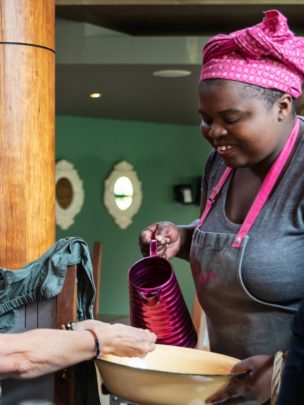

The menu was extensive with many choices featuring the best and freshest African produce. There was much enthusiasm and discussion about some of the traditional items on the menu before we had our orders finalised. We were discussing our earlier trip to Robben Island when Theresa arrived with her brushes and suggested she paint our faces while we waited for our meals. The styles were apparently traditional, but the application method seemed more modern. By the time our meals arrived, about 200 photos later, we were all beautifully adorned.
My seared calamari with olives and lemon buttery sauce was delectable, but I also helped my friend with her amazing crumbed prawns and hand-cut chips. This was a real treat for a gluten-free person usually deprived of most crumbed dishes. To top off this relaxing afternoon, we thought we should also test the cocktails. Mine was actually a mango mocktail, but it was full of fruit and very delicious.
Refreshed and satisfied, we decided it was time to explore the spectacular gardens, which were created from what was once nothing more than ramshackle farmland overrun with pigs. In 1913 a botanist called Harold Pearson was commissioned by the government to transform the land into a botanic garden devoted to the country’s indigenous flora. The 528-hectare Kirstenbosch Estate (which includes the garden) falls within the Cape Floristic Region (CFR), which is a UNESCO World Heritage Site and a global biodiversity hotspot of similar heritage status to the Galapagos Islands and the Grand Canyon.
The CFR covers the Mediterranean climate region of South Africa from the Western Cape in the southwestern corner of the country eastwards into the Eastern Cape. With an area of 78,555 square-kilometres (about the size of Portugal) the CFR represents less than 0.5 per cent of the area of Africa but is home to nearly 20 per cent of the continent’s flora. Wow, indeed! Part of the CFR is the Fynbos Biome, home to more than 9,000 species of vascular plants, of which 69 per cent are endemic to this area and occur nowhere else on earth.
Fynbos is the name given to the hard leaved shrublands and heathlands immediately north and east of Cape Town. Dominant plant groups include the proteas, erica, restios and geophytes. Protea are one of the most well-known and the King Protea (Protea Cynaroides), is South Africa’s national flower.
You could while away a very pleasant afternoon here. Oh, yes, that’s exactly what we did. Including this place on our schedule was an inspired and popular choice. The flowering annuals, proteas and other fynbos plants present such a dazzling array of colours, shapes and textures that it’s difficult to know what to photograph next. Thank goodness for digital technology!

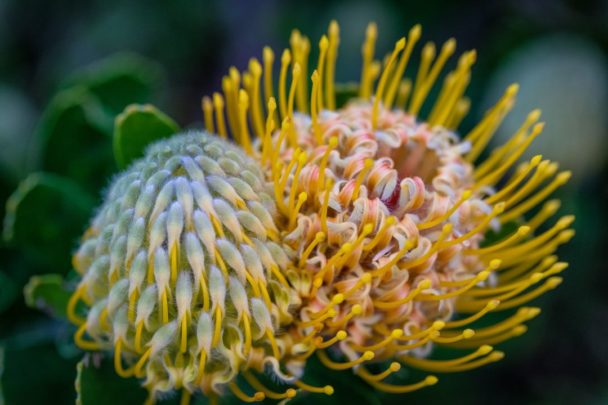
We wandered along garden paths, enjoyed the vista, sat on park benches and chatted, took photos of gorgeous flowers and marvelled as the birds enjoyed the nectar from the proteas. Southern double-collared sunbirds and orange-breasted sunbirds flitted happily from flower to flower.

As the afternoon closed in, I left my dawdling compatriots to their own devices and headed to the Boomslang Tree Canopy Walk for some photos before sunset. The walk, named after the boomslang snake, seemingly writhes its way amongst the treetops giving an awesome view of the gardens below. It was a popular place for people of all ages as the sun dipped behind the mountains.

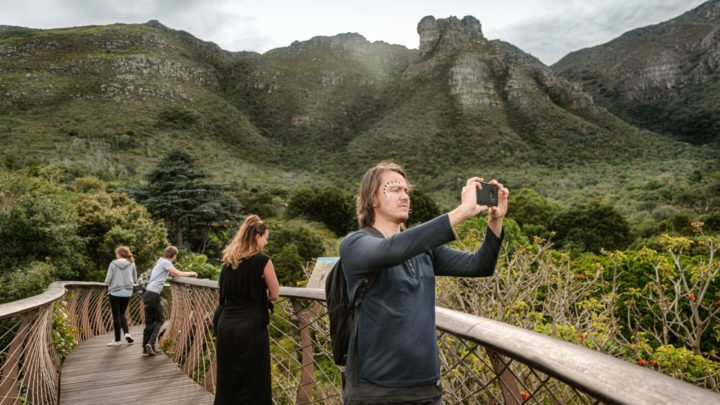
As we wandered back to our bus, we were told there was an owl asleep in a tree around the corner, so back we went. Wow! There he was! A Cape eagle-owl was perched asleep in a tree about two metres from the ground, where he stayed, opening one eye occasionally to check on us, while we took photos from all angles and hoped he would open at least one eye for just a little longer.
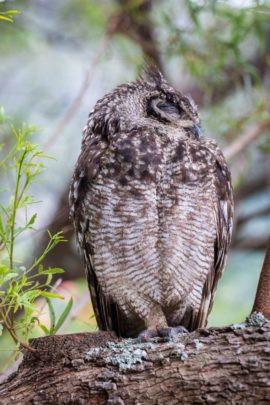
There are always flowers and interesting plants to be seen at Kirstenbosch and every season has its charm, however, to see the Fynbos at its best, you should visit towards the end of winter, in spring or in early summer (August-November).
There is much to see and do at Kirstenbosch Garden including:
The Kirstenbosch National Botanic Garden is open daily from 8am to 7pm during summer (September-March) and 8am to 6pm during winter (April-August). There is a modest entry fee of 75 Rand (AU$7.50) per adult and children under 6 years of age are free. All visitor facilities, i.e. entrance gates, restaurants, shops and venues, are accessible for wheelchairs, however, Kirstenbosch is set on a very steep gradient and not all areas of the garden are accessible to wheelchairs. Visitors in wheelchairs will need assistance when they visit the areas of the garden on the steep upper slopes, such as the Tree Canopy Walkway, Fynbos Walk and Protea Garden. Kirstenbosch has a ‘No Bin Policy’, so rubbish bins are not present in most parts of the garden. This is intended to discourage scavengers like rats and it keeps the garden cleaner. Visitors are expected to take their refuse with them when they leave the garden.
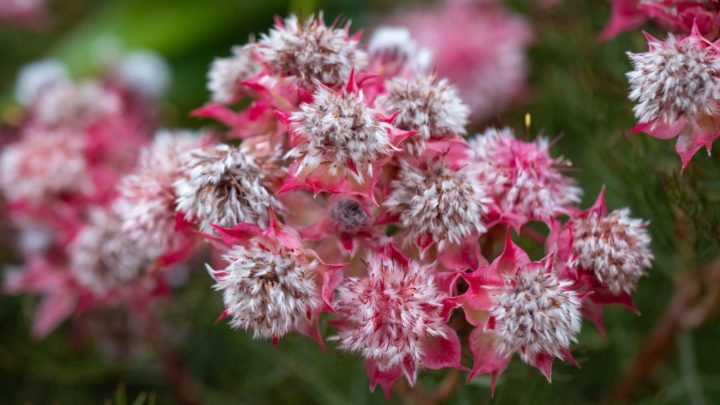



With its acres of colourful proteas and other beautiful flowers in bloom high on the hill above Cape Town, Kirstenbosch Garden is quintessential spring in South Africa and not to be missed!